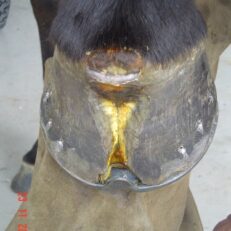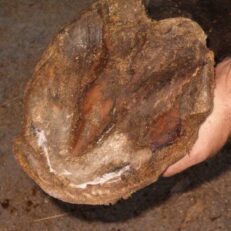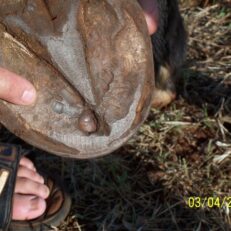Many horse owners and riders are unable to recognise the symptoms that indicate the beginnings of an abscess.
If detected early, most abscesses can be treated in a simple fashion and the horse can be returned to work within hours. However, if an abscess is missed for a day, it will build up pressure within the hoof and can cause more serious associated problems and take weeks to fix.
There are four types of abscesses that can occur in the hoof and long before they become visible, you will have noticed a change in your horse’s attitude or a slight change in the regular gait, or unevenness; often they will rest one leg and point the hoof. You must be aware enough to notice these changes – it is your duty of care.
If you suspect an abscess, look for a digital pulse in the suspect leg (this is an early indication of trauma within the hoof). To do this place thumb and forefinger either side of and above the fetlock joint just behind the tendon. Note the pulse then compare it with the opposite leg. If the pulse appears to be accelerated or stronger you can be fairly sure there is an abscess forming somewhere in that hoof.
In the event that no strong pulse can be found in the suspect hoof, try testing the diagonally opposite one; this sometimes solves a phantom head bobbing lameness.
At this point the decision needs to be made whether you are capable of carrying out further treatment or if you should call an experienced farrier or the vet. As with any treatment of hoof abscesses, prescribed antibiotics should be given.
If shod, the shoe should be removed at this point as it will restrict your mission of discovery. The hoof testers should be used to gently pressure test around the outer edge of the hoof wall beginning at one heel and moving at intervals to the other heel to see exactly where it is sensitive.
The four types of hoof abscesses are Toe, Sole, Bar and Heel which each have a cause, an effect and a treatment.
TOE ABSCESS
THE CAUSE.
The toe abscess will be found at the junction of the sole and the hoof wall between the white line and the sensitive laminae.
It usually starts from the hoof wall being too long, causing it to flare out and separate from the laminae. Often the hoof wall cracks vertically, allowing dirt and grit to build up inside against the sensitive tissue which when aggravated becomes inflamed then infected.
THE EFFECTS
The horse will stand with the leg pointed forward to relieve the pressure at the toe, and will show a head bobbing action at the trot.
THE TREATMENT
The separated or cracked area must be thoroughly cleaned out to remove all dirt and grit. This can be done by flushing or by using a narrow blade sole knife or similar and can be achieved without causing blood flow. The flares at the toe must also be reduced back to an even hoof wall thickness at this time to prevent stress. If the abscess is not yet visible, a poultice should be applied to the complete sole, (use as directed) to try drawing out the intrusion; this may need to be repeated until lameness is eased.
Some toe abscesses will travel up through the hoof wall and blow out at the coronary band – these need to be poulticed in that area. The long term effects of these top releasing abscesses will be seen about two months later, when a small horizontal crack appear in the hoof wall directly above where the original abscess was, and just below the coronet. It will grow down as the hoof grows, and will need to be opened up to prevent it from holding dirt and causing another abscess. There will be a capillary track from this horizontal crack down to the tip of the hoof which must be opened and cleaned, and if necessary refilled with synthetic material (used as directed)
SOLE ABSCESS
THE CAUSE
The cause is either from bruising to the sole (which is common to wide flat footed horses) and usually results from the sole not being concave enough to allow free movement downwards when the hoof is under load), or from a stone bruise which may also puncture the sole; these usually occur in the front half of the sole.
THE EFFECT
Accelerated digital pulse, pointing the toe, hoof feels warm to touch, often swelling in the lower leg and obvious lameness.
TREATMENT
For a blind sole bruise/abscess there is sub-surface bleeding and this can be treated first with an ice boot or similar until any heat or swelling has subsided, then protected with an under-pad fitted between the shoe and hoof and left in place for a week or two as protection for the affected area. It is not advisable to try to drain this type of abscess by opening up the sole; it increases the risk of infection and delays the soundness. As soon as the bruise has subsided, any excess thick or crusty sole should be pared away to achieve a concave profile which will help in the rehabilitation of the hoof and the prevention of another bruise.
In the event that the sole has been punctured by a stone, there will already be bleeding from that point so it needs to be cleaned and disinfected and a poultice applied to draw out any dirt etc. The punctured area needs to be protected with a pad or boot for a few weeks to allow the sole to heal over, and the horse must be given antibiotics.
HEEL ABSCESS
THE CAUSE
These occur in the corn area at the junction where the bars meet the heel buttresses.
The cause is from excess pressure from the bar under the heel of the shoe, or from high impact to the heels as a result of the heels of the hoof capsule being too high; this starts off as bruising and progresses to inflammation and finally becomes abscessed.
THE EFFECTS
Acute lameness, strong digital pulse, horse will rest the leg toe first with the heel off the ground. There will be visible swelling in the lower leg and hoof feels warmer to touch.
THE TREATMENT
Trim the bars down to sole level and lower the heels to expose the bruised area. Apply a poultice and repeat until soreness has eased, trim the hoof to achieve a straight line from the front of the pastern down to the tip of the hoof and remove all flares in the hoof from toe to heel. Sometimes a heart bar shoe will be necessary to help the hoof return to normal by easing further pressure at those heels during rehabilitation.
BAR ABSCESS
THE CAUSE
Occurs about half way back along the bar where a crack develops when the bars have not been maintained to a short strong profile.
THE EFFECTS
When the bar cracks there is almost always an infection, extreme lameness, swelling, and pulse, and then progresses to an under run sole abscess.
TREATMENT
Carefully clean the affected area of all dirt and excess flaky sole, disinfect and apply a poultice for about three days, repeating the cleaning process each time. When the soreness decreases, a straight bar shoe and an under pad should be fitted as protection.
About six weeks after the initial infection from a cracked bar, if there has been an under run infection, the sole will feel hollow in that area and occasionally at least half of the sole will be affected. Care should be taken not to pare away this separated sole too soon as nature is using it as a buffer until the new sub-sole is strong enough to protect the pedal bone. Be patient as it will remove easily when it is ready and not before.
CONCLUSION
Hoof abscesses are unnecessary and prevention is far better than cure. Avoid allowing flares to develop in the hoof wall – this will eliminate cracks and laminae separation which invite the abscess. Balance the hoof to the correct pastern angle to eliminate heel damage, trim the sole to its natural concavity and trim the bars to be strong. This will solve most potential hoof related lameness problems.



